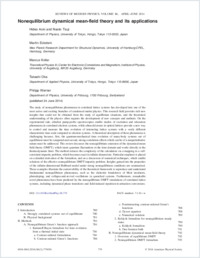Nonequilibrium dynamical mean-field theory and its applications
- Aoki, Hideo Department of Physics, University of Tokyo, Japan
- Tsuji, Naoto Department of Physics, University of Tokyo, Japan
- Eckstein, Martin Max Planck Research Department for Structural Dynamics, University of Hamburg-CFEL, Hamburg, Germany
- Kollar, Marcus Theoretical Physics III, Center for Electronic Correlations and Magnetism, Institute of Physics, University of Augsburg, Germany
- Oka, Takashi Department of Applied Physics, University of Tokyo, Japan
- Werner, Philipp Department of Physics, University of Fribourg, Switzerland
-
24.06.2014
Published in:
- Reviews of Modern Physics. - 2014, vol. 86, no. 2, p. 779–837
English
The study of nonequilibrium phenomena in correlated lattice systems has developed into one of the most active and exciting branches of condensed matter physics. This research field provides rich new insights that could not be obtained from the study of equilibrium situations, and the theoretical understanding of the physics often requires the development of new concepts and methods. On the experimental side, ultrafast pump-probe spectroscopies enable studies of excitation and relaxation phenomena in correlated electron systems, while ultracold atoms in optical lattices provide a new way to control and measure the time evolution of interacting lattice systems with a vastly different characteristic time scale compared to electron systems. A theoretical description of these phenomena is challenging because, first, the quantum-mechanical time evolution of many-body systems out of equilibrium must be computed and second, strong-correlation effects which can be of a nonperturbative nature must be addressed. This review discusses the nonequilibrium extension of the dynamical mean field theory (DMFT), which treats quantum fluctuations in the time domain and works directly in the thermodynamic limit. The method reduces the complexity of the calculation via a mapping to a self-consistent impurity problem, which becomes exact in infinite dimensions. Particular emphasis is placed on a detailed derivation of the formalism, and on a discussion of numerical techniques, which enable solutions of the effective nonequilibrium DMFT impurity problem. Insights gained into the properties of the infinite-dimensional Hubbard model under strong nonequilibrium conditions are summarized. These examples illustrate the current ability of the theoretical framework to reproduce and understand fundamental nonequilibrium phenomena, such as the dielectric breakdown of Mott insulators, photodoping, and collapse-and-revival oscillations in quenched systems. Furthermore, remarkable novel phenomena have been predicted by the nonequilibrium DMFT simulations of correlated lattice systems, including dynamical phase transitions and field-induced repulsion-to-attraction conversions.
- Faculty
- Faculté des sciences et de médecine
- Department
- Département de Physique
- Language
-
- English
- Classification
- Physics
- License
-
License undefined
- Identifiers
-
- RERO DOC 231841
- DOI 10.1103/RevModPhys.86.779
- Persistent URL
- https://folia.unifr.ch/unifr/documents/303777
Statistics
Document views: 160
File downloads:
- pdf: 328
